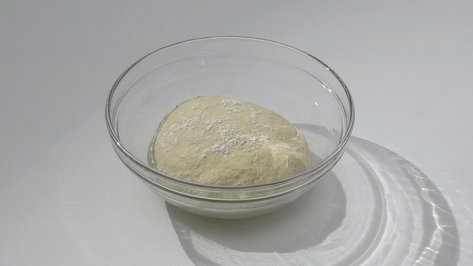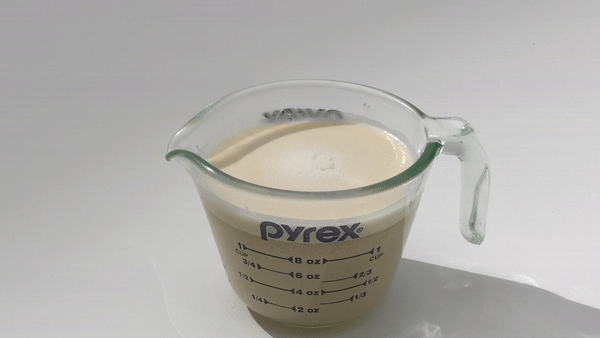What Fungus Makes Bread Rise
Research News
Come across baker's yeast, the budding, unmarried-celled fungus that fluffs your bread

Dough rising in a 100-infinitesimal time-lapse blitheness. In bread dough, baker's yeast, or Saccharomyces cerevisiae, digests sugar and releases carbon dioxide. The CO2 forms bubbles in the dough and causes it to expand. Photo: Douglas Levere
Past CHARLOTTE HSU
They live in bread dough. They dice in your oven.
At the grocery store, where you buy them, they sit down in picayune glass jars, fallow on the shelf, waiting to be rehydrated then they tin do their life's piece of work, eating sugar and releasing carbon dioxide to form bubbles in your breadstuff.
Baker's yeast has get a sought-after pandemic commodity as people broil at home.
But how much practice you actually know almost this organism, a single-celled fungus that scientists phone call Saccharomyces cerevisiae?
As it turns out, bakery'southward yeast is a common model organism that researchers use to written report biological processes, including disease. A number of biologists in the College of Arts and Sciences regularly grow the species in their labs, and a few took fourth dimension to talk over the wacky, wonderful science of Due south. cerevisiae.
What is baker's yeast?
"Yeast is a mucus that grows as a single cell, rather than as a mushroom," says Laura Rusche, acquaintance professor of biological sciences.
Though each yeast organism is fabricated up of but ane cell, yeast cells alive together in multicellular colonies. They reproduce through a procedure called budding, in which a "female parent jail cell" grows a protrusion known as a "bud" that gets bigger and bigger until information technology'south the same size as the mom.
"That's the daughter cell, and it splits off," says Sarah Walker, assistant professor of biological sciences. "They're unmarried-celled organisms, so they don't grow to become mushrooms or anything like that."
When food supplies run low or the environment gets harsh, S. cerevisiae can produce special stress-resistant cells chosen spores that can stay dormant for long periods of time, germinating when conditions improve. Regular, not-spore yeast cells can also be preserved through freezing.
"Yeast cells tin hunker down and look — they can go into a sort of suspended animation to survive stress," Walker says. "We tin can't exercise it, but they tin can. In the lab, we put them in a -fourscore Celsius freezer, so it'southward a deep freeze, and they are stable for years and years. Later, we accept a niggling bit of the ice out of the frozen civilisation, and information technology starts growing again."
What does yeast do in nature?
Baker'due south yeast, or Saccharomyces cerevisiae, seen through a microscope in the lab of UB biologist Laura Rusche. Each round object is an private yeast cell. The cells pictured are a laboratory strain of S. cerevisiae, but wild yeast look essentially the same, Rusche says. Photograph: Ashleigh Hanner
Out in the earth, yeast is all over — on tree sap, on grape skins, on fallen fruits. The organisms drive the procedure of decay, helping to pause down plant material.
"Where is yeast plant in nature? Information technology is plant everywhere," Rusche says. "It makes little spores, and those spores are kind of just effectually. Where it proliferates is on rotting vegetative matter, rotting fruit. Information technology likes sugar."
"For a long time, people used to lump plants and fungi together, but they're biologically different," she adds. "Plants do photosynthesis. Fungi don't. Fungi live on decaying material, on things similar rotting woods, and they're eating the stuff that other organisms have left behind, whereas plants are making their own food through photosynthesis."
Walker explains that Due south. cerevisiae and other yeast species swallow sugar and produce byproducts including carbon dioxide (responsible for the air pockets in leavened bread) and booze (recall wine and beer).
"Yeast evolved to take advantage of high-carbohydrate plant material that came about when flowering plants emerged," she says. "The plants brand sweetness fruits to concenter animals to motion their seeds around, but the fruits generally get dropped on the ground, and they rot, and the yeast are taking advantage of all this. They're what's doing the rotting."
Why do scientists use baker's yeast in the lab?
Colonies of baker'south yeast, or Saccharomyces cerevisiae, pictured nether a microscope. Yeast don't grow this way in bread dough: The images are from a 2016 study in the lab of UB biologist Paul Cullen that explored cellular mechanisms that cause sure changes in yeast growth patterns. In glucose-rich weather on a flat laboratory plate (left), the yeast cells grow in a tight cluster. But when glucose is limited (right), new cells grow outward, forming a filament-like configuration that may assistance in the search for food. Photograph: Paul J. Cullen
Researchers harness baker's yeast to report a diversity of biological processes.
Rusche's lab uses S. cerevisiae to learn more almost how certain genes go switched on or off in response to stress. Walker's team uses the organism to probe the intricacies of mRNA translation, which causes cells to produce proteins.
This research sheds calorie-free on the bones biology of S. cerevisiae. But the work could too improve understanding of cellular processes in other species, ranging from disease-causing yeasts to humans.
Scientists similar to work with baker's yeast because it's cheap, its genetic material is easy to manipulate, and researchers already know a lot nearly it. Yeast also grows quickly.
"Yeast cells are a good model organism because you tin can grow a civilization overnight. Doubling time is simply an hour-and-a-half, whereas if you're growing a mammalian cell culture, it tin take a few weeks," Walker says. "A lot of the fourth dimension, yeast has a pared-downward version of the genetic machinery that'south required for similar processes in higher organisms. So sometimes we do our initial work in yeast, and so we attempt to follow upwardly on promising results in mammalian cells."
"It's a actually well-established lab organism, and then if you acquire something new about Saccharomyces, you tin put it in the context of everything else that the whole community has already learned about that organism. Yous can chronicle the data to what y'all already know," Rusche says. "If you go to a species that hasn't really been studied and y'all make a discovery, y'all accept a slice of information in isolation."
Whatever tips for bakers and brewers?

Baker's yeast, Saccharomyces cerevisiae, proofing with sugar and water in a 40-infinitesimal fourth dimension-lapse animation. Photo: Douglas Levere
Christopher Rupert, a PhD candidate in Rusche's lab, says 1 of the keen things about yeast is that these organisms evolved non to help humans brand staff of life and beer, only to survive in their ecological niches.
"A lot of people associate yeast with beer and staff of life. Yeast ferments — it takes in saccharide and spits out alcohol and CO2 — and that's why we love information technology so much," he says. "Merely what's interesting is that it is hypothesized that this evolved as a way for yeast to fight other micro-organisms. Yeast has a college alcohol tolerance, so when information technology is secreting booze, information technology is killing bacteria effectually it, so it'due south the just one that'due south left."
Rupert's dissertation deals with the yeast species Candida parapsilosis, which can cause human infections. But he did undergraduate research on S. cerevisiae, and also uses it at home — he'south an avid baker, making dinner rolls, burger buns, buttermilk biscuits and sourdough bread. He seeded his with some baker's yeast, but information technology also contains wild yeasts of dissimilar species.
"When we used to go into the lab, he would bring stuff in for us to sample," Rusche says, recalling the days earlier social distancing. "We would always get all his treats."
Because yeasts did not evolve specifically to help humans, humans must cater to the needs of yeasts.
For example, S. cerevisiae thrives at temperatures of about 85 degrees Fahrenheit, which is why seasoned bakers oftentimes keep their rising dough somewhere warm. Too cold, and the yeast will be slow to grow. Too hot, and information technology will die.
When it comes to making wine, choosing the right species of yeast tin be important, equally some can tolerate higher levels of alcohol than others. If your yeast dies before information technology'south able to consume all of the carbohydrate, your drinkable might turn out also sweet, says Walker, who has a peach tree in her grand and makes peach wine.
"If you bake or brew with yeast, you lot have a living organism. Y'all have to requite it fourth dimension and a nice warm environment," Rusche says. "Humans domesticated Saccharomyces cerevisiae, just in that location are so many different species of yeast in the globe. Sourdoughs contain a lot of wild yeast, and many of those are non Saccharomyces. They're such interesting organisms."
What Fungus Makes Bread Rise,
Source: https://www.buffalo.edu/ubnow/stories/2020/07/yeast.html
Posted by: albrittonoughted2001.blogspot.com


0 Response to "What Fungus Makes Bread Rise"
Post a Comment